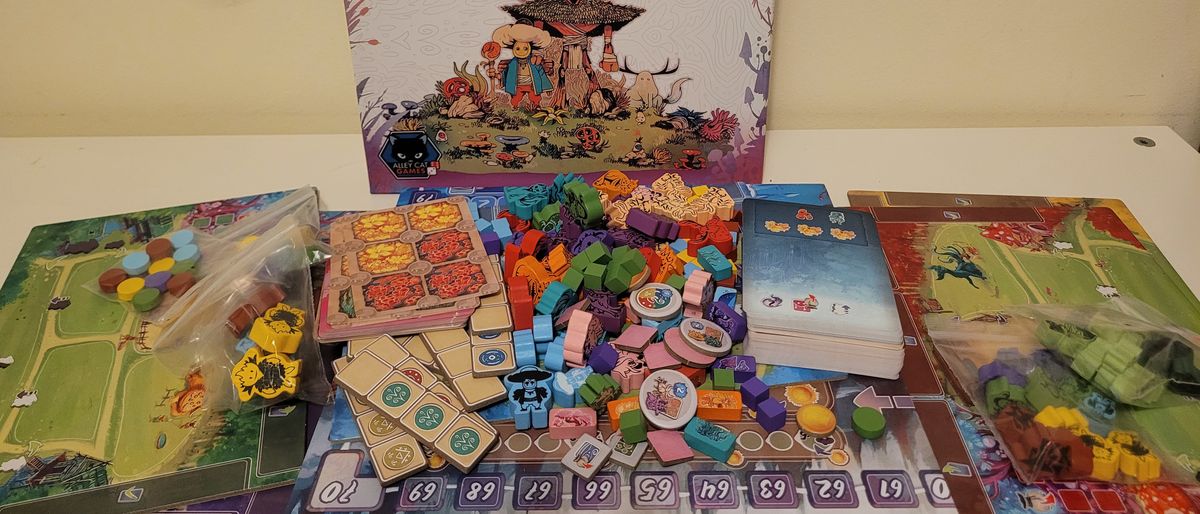12DOVE Verdict
For fans of heavyweight strategy board games, Arborea will be right on the money. Although it leans into the worker placement trappings you may have seen before, a few twists have been added to keep veterans on their toes. Yes, it lacks narrative behind its mechanics and that vibrant art style is divisive... but its tactical depth and replayability are undeniable.
Pros
- +
Shared placement and resource tracks provide lots of positive player interaction
- +
Lots of interlinked mechanics offer lots of challenge and strategic depth
- +
Varied setup means there’s plenty of replay value
Cons
- -
Difficult to learn and visually divisive
- -
No sense of theme or narrative - feels more like a grab-bag of game mechanics
Why you can trust 12DOVE
Arborea is a little bit different.
Post-apocalyptic games are ten a penny. Post-apocalyptic games where you play as a disembodied spirit that guides villagers to rebuild and repopulate the shattered ecosystems of a fantasy planet… well, are not. Yet those are the ethereal shoes that Arborea asks you to fill as you compete with other such spirits to see whose tribe can contribute most to revitalizing the landscape.
Arborea features & design
| Price | $60 / £55 |
| Ages | 14+ |
| Genre | Worker placement |
| Complexity | High |
| Players | 1 - 5 |
| Lasts | 90 - 120mins |
| Made by | Dani Garcia (designer), Nico Gendron & Javier Inkgolem (art) |
| Publisher | Alley Cat Games |
| Play if you like | Agricola, Darwin’s Journey |
- A surprisingly colorful post-apocalypse
- Strategic worker placement game
- Tactical, but not aggressively competitive
In Arborea, you take control of a Patron Spirit (represented with cheerful meeples) that must direct villagers to heal the landscape. Basically, this is a worker placement game - a genre that’s been the staple for heavy strategic fare amongst the best board games for some years now.
Practically speaking, each player has a pool of workers which they place on board spaces to gain resources and actions. They then spend those resources and actions in various ways to try and gain points. Rinse and repeat.
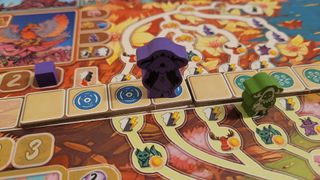
Still, Arborea offers a twist to the conventions of the genre by having you place workers onto conveyor-belt-like pilgrimage tracks. On their turn, players can either place a worker onto one of these tracks or 'push' the conveyor tile one square along, shifting all other workers on the track along with it.
Many of the rewards you’ll get from moving down a trail involve generating biome resources. The tracks for these have two pieces, split into an upper and lower segment. When you gain a resource, you push the upper marker up one and when you spend it, you push it down. If, at the end of your turn you have unspent resources, then you move the lower marker up to meet the upper one, gaining points for each one you pass. That leaves the resource markers up several spaces on the track, meaning future players can spend them, even though you did the work to gain them.
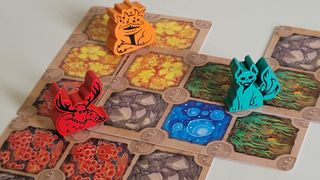
In terms of how it looks, Arborea is a colorful, visually-arresting game with a distinct voice. However, the board can be hard to read because it's so busy, and confusing iconography muddies the water somewhat.
Biome resources are mostly spent on playing ecosystem cards, which you can gain from other trail actions. These cards have six habitat squares on them, and you can lay them adjacent or even atop one another to create different patterns of habitats. Creatures, which you also gain from trail actions, get places on the intersections between four habitat squares and will give you the majority of your points when the game ends. Different creatures score bonuses for different adjacent habitat spaces.
There are several other mechanics of note. An additional resource, called spirit, can be spent to let you take extra placements, pushes, or trail runs during your turn. The board also features sages, which you can give gifts to as a trail action, allowing you to gain benefits from the associated sage when you play a card with the matching icon on the back.
Arborea is a colorful, visually-arresting game
Finally, there is also a season track on which you can advance if you place workers on tracks with an associated icon. Each season has a specific objective, like collecting spirit, and your position on the track at game end acts as a points multiplier.
It should be noted that this is not a comprehensive explanation. There are a lot of minor intersections between various aspects of the game that need to be played to be understood, although the rulebook does a good job of explaining the game’s intricacies.
Arborea gameplay
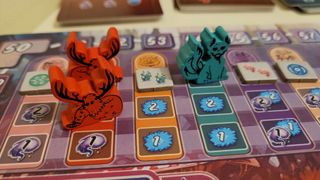
- Pushing other player’s workers and leaving them resources creates an interesting form of positive interaction
- Interplay of resource gain with the spatial puzzle of creating habitats and placing animals offers lots of strategic depth
- Never feels like a thematic whole, just a set of interlocking mechanisms
Worker placement board games for adults like this offer a lot of strategic depth, but they also, on the whole, tend toward being very insular, with each player pursuing their own plan. Arborea stands out by offering a lot of shared mechanics, where your decisions have direct, non-negative consequences for other players. You can push a track to advance your own workers, but you’ll be helping other players with workers on the same conveyor. You can hoard resources to gain points, but that’ll leave them open for other players to spend and boost their chances on their turn.
This results in a fascinating interplay of dynamics, which are often double-edged swords. Of particular note is that you can only run trails after your initial push or placement, but you get a free push afterwards at the end of your turn. That means if you need resources now, you may be forced to spend your turn on a push just to get your worker where you need them, and boost other player’s workers at the same time.
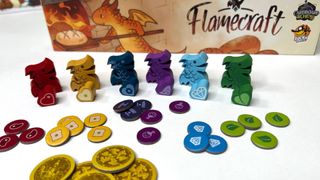
If this sounds up your street, there are plenty of other worker placement games out there. The animal-filled Everdell is one of the most notable examples, while Dune: Imperium is a great alternative thanks to its twist of hidden info. A recent favorite of ours is Flamecraft, a game about adorable dragons working as bakers, potion-makers, and more.
You can always lavish some spirit to place a worker, too, but that’s in short supply and can bite you badly with penalties at the game end if you’re in arrears. Cleverly, while it feels like your decisions have major consequences for other players, they’re only beneficial. No-one is going to feel like they’re being attacked, or having things taken from them.
Beyond this unusual interplay, Arborea plays a lot like a typical heavyweight strategy game. You’re forever juggling different priorities as you try and put things in place to get the resources, animals and cards you need to create and populate your habitats. Those habitats, in turn, are a puzzle in and of themselves as you struggle to create an optimal set of terrain while also gaining the highest-scoring creatures to sit in it. All the while, you must also spend time trying to tick off the game’s less central, but still critical, actions, like creeping up the seasonal bonus tracks and making sure your young and veteran workers return to your supply and are ready to place on the board again.
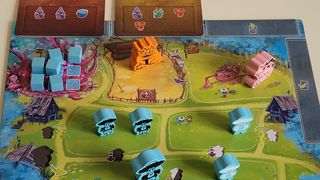
Of particular note is the gifting mechanic because it’s a little mini-game in its own right. Worker placement games often have an engine-like feel as you spend resources for the opportunity to gain more resources in the future. Arborea doesn’t do that directly, but the sage gifts can feel a little bit like it.
Each sage offers a different menu of rewards, and the more gifts you give, the more rewards you get. So it’s generally better to focus on one or two of them to try and specialise, using this as a basis to propel your overall strategic focus forward.
However, for all that Arborea manages to offer a deep challenge to master and to stand out among its peers with some unique mechanical twists, it’s not without problems.
Arborea manages to offer a deep challenge to master and to stand out among its peers with some unique mechanical twists
In particular, despite the clear visual theme of rebuilding a post-apocalyptic landscape, in reality it is a highly abstract game. You never really feel like you’re doing anything other than manipulating complex systems to gain points, which can begin to feel a little hollow after a while. And it’s hard to escape a feeling that some of those systems only exist to give you more options to fiddle with.
It’s also a rather impractical game on multiple levels. It’s hard to teach, and takes a couple of hours to play. The board is incredibly busy and difficult to read with its riot of colors, confusing iconography and multiple functions cramped together. It’s also a table hog even at the point of setup, after which each individual player’s habitat cards can spread in unpredictable directions, eating up even more space.
Should you buy Arborea?
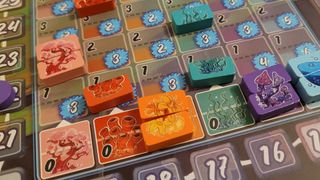
If you’re a fan of big, heavyweight strategy fare, then Arborea should be on your to-play list. It satisfies all the basics of that style of game, while the focus on shared resources and positive interaction – plus the blaring, divisive visual style – help it to stand out from the crowd. It’ll take a few engaging plays to get the game flow down, after which varying rewards for the season and animal tracks mean you’ll have to vary your strategic choices each play, providing good replay value.
However, if you’re new to this genre or someone who actively dislikes it, this isn’t a route in. It’s too obtuse, both in terms of rules and visuals, and can’t provide any narrative or thematic satisfaction beyond its challenging strategy.
Buy it if...
✅ You’re a fan of deep, demanding strategy games
Arborea will challenge you, so fans of a more layered experience will find a lot to love here.
✅ You’re on the lookout for novel board gaming concepts
This doesn't take the easy, well-worn path; it dares to be different. Arborea will breathe new life into games night as a result.
Don't buy it if...
❌ You struggle with a lot of rules or unfamiliar concepts
There's a lot to take in here, and Arborea's unique approach can be a double-edged sword.
❌ You prefer games to have lots of random or narrative elements
For all its visual pop, Arborea doesn't delve too deep into its story. The appeal lies in its stellar mechanics.
How we tested Arborea
Disclaimer
We reviewed Arborea using a copy of the game provided by the publisher.
This review is the result of hands-on playtest sessions to get a deeper understanding of the game's mechanics. That means we spent a decent chunk of time exploring its systems and generally living with it for a better idea of its longevity.
You can learn more on this process in our guide to how we test board games and tabletop RPGs, or the more general 12DOVE reviews policy page.
For recommendations of what to try next, be sure to check out our board games for 2 players guide. You can drop in on our best cooperative board games feature, too.
Matt is a freelance writer specialising in board games and tabletop. With over a decade of reviews under his belt, he has racked up credits including IGN, Dicebreaker, T3, and The Guardian.

Wherever you go and whatever you do, the ultra-portable, AI-powered MSI Prestige series laptops work for you

New Lego sets in April 2025, from Lord of the Rings to Beauty and the Beast

Assassin's Creed Shadows was originally envisioned without Yasuke, but Ubisoft wanted the full feudal fantasy: "We were sort of making a stealth tank, and it didn't quite work"
